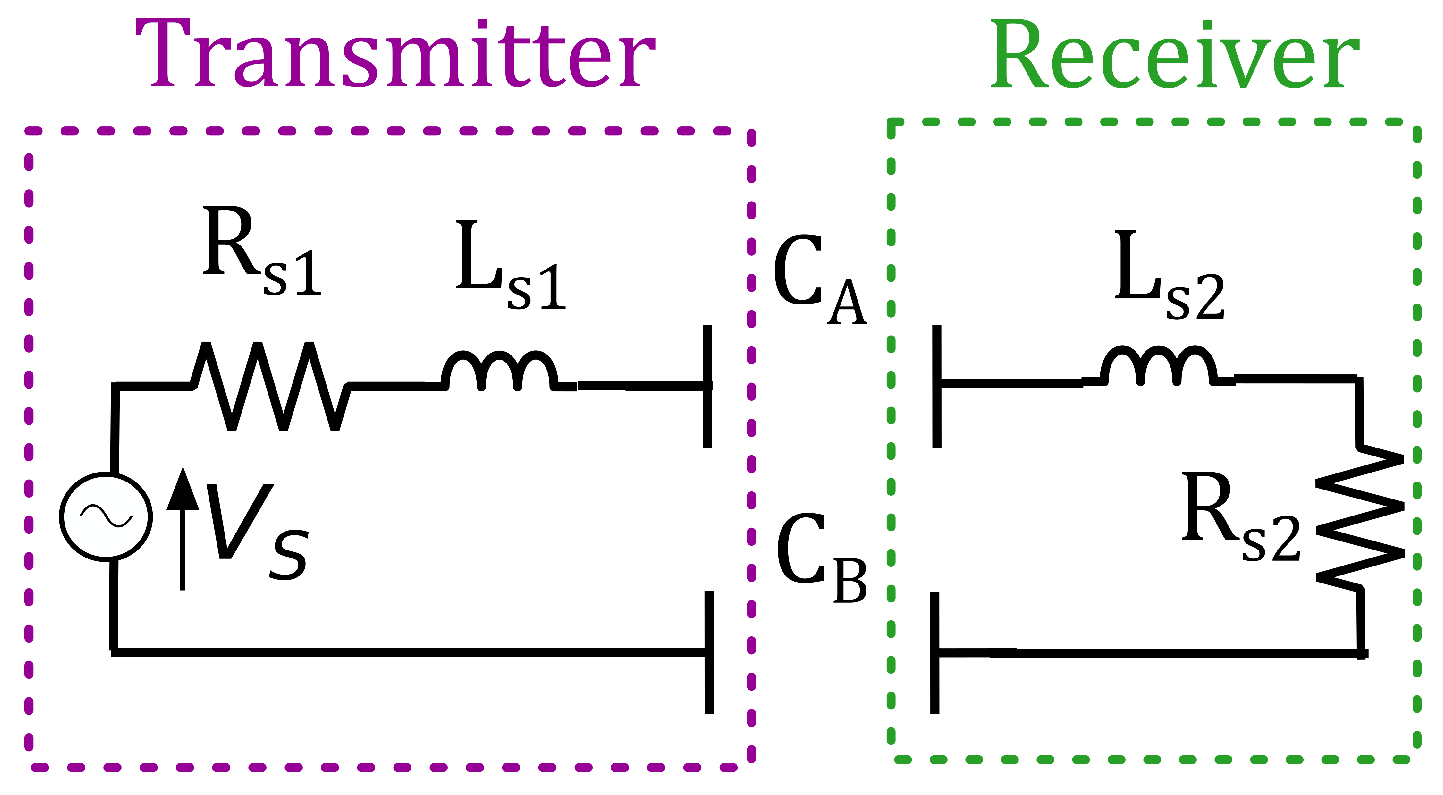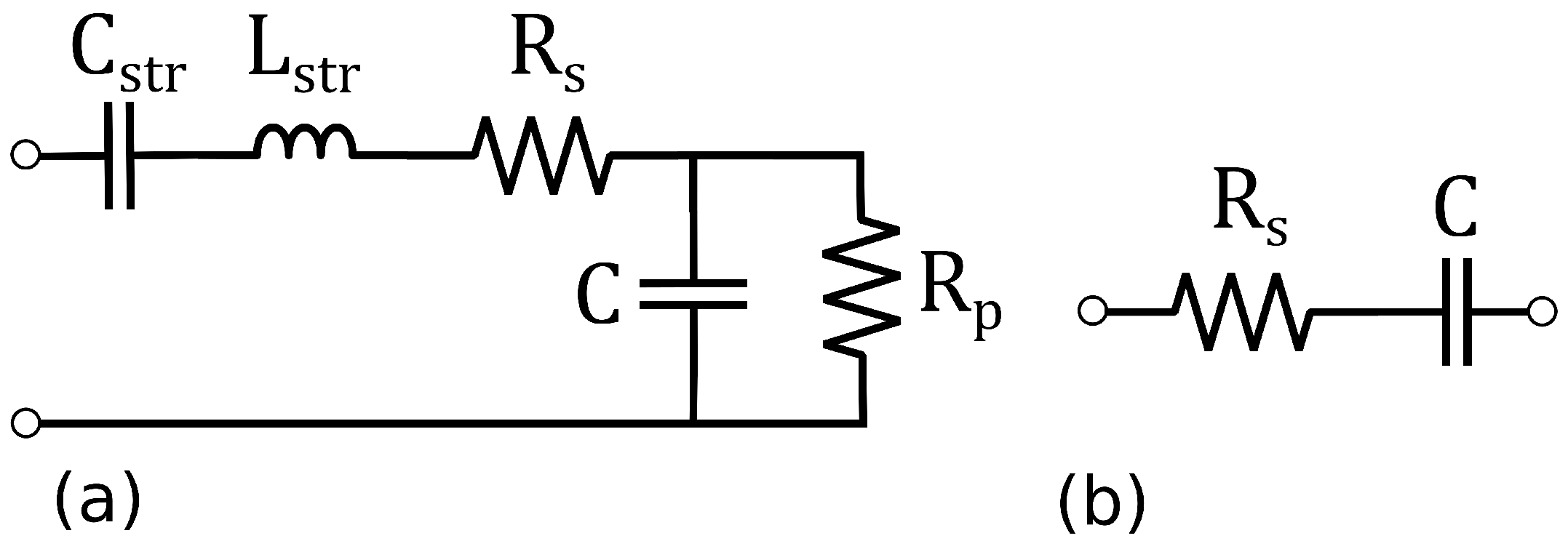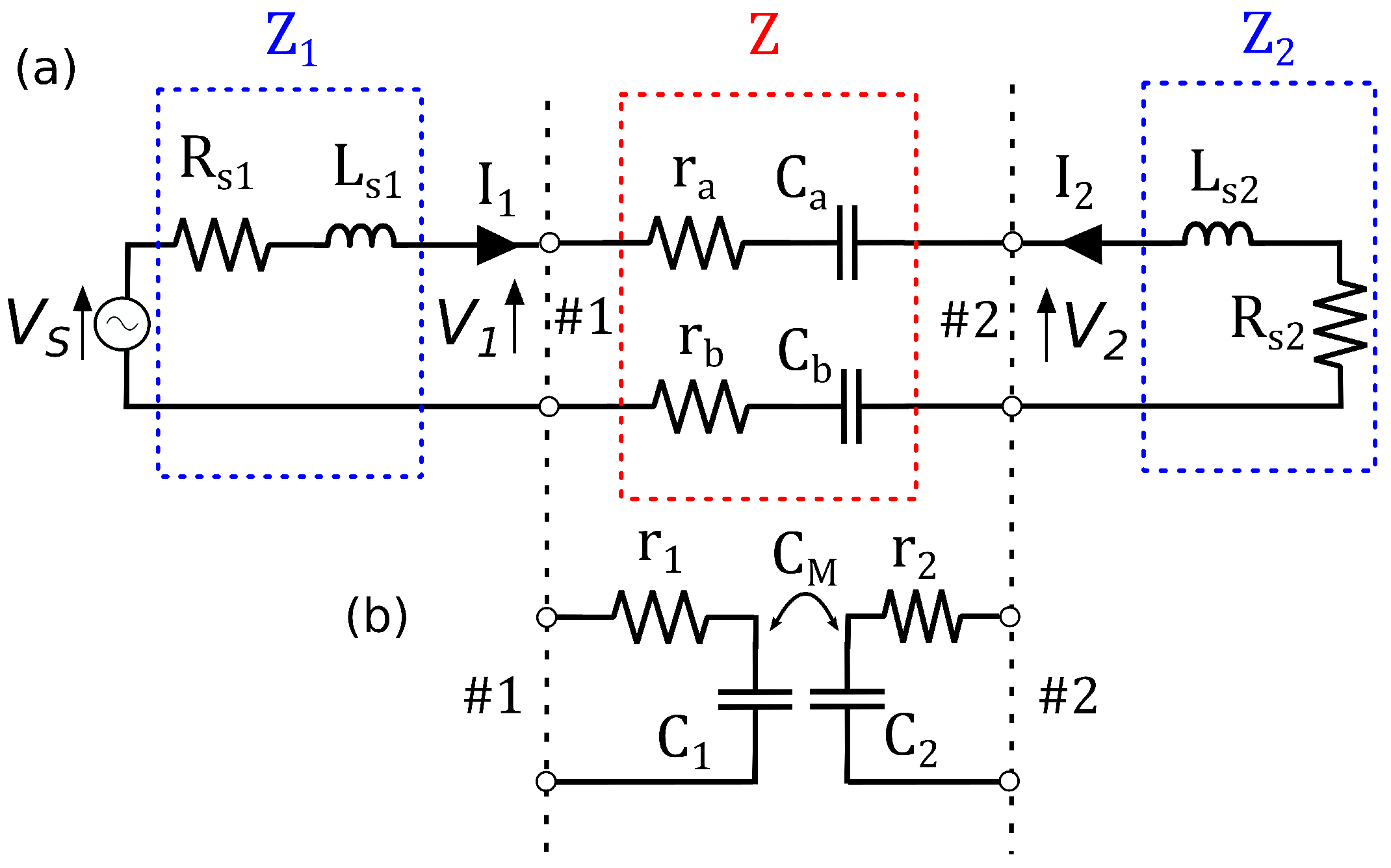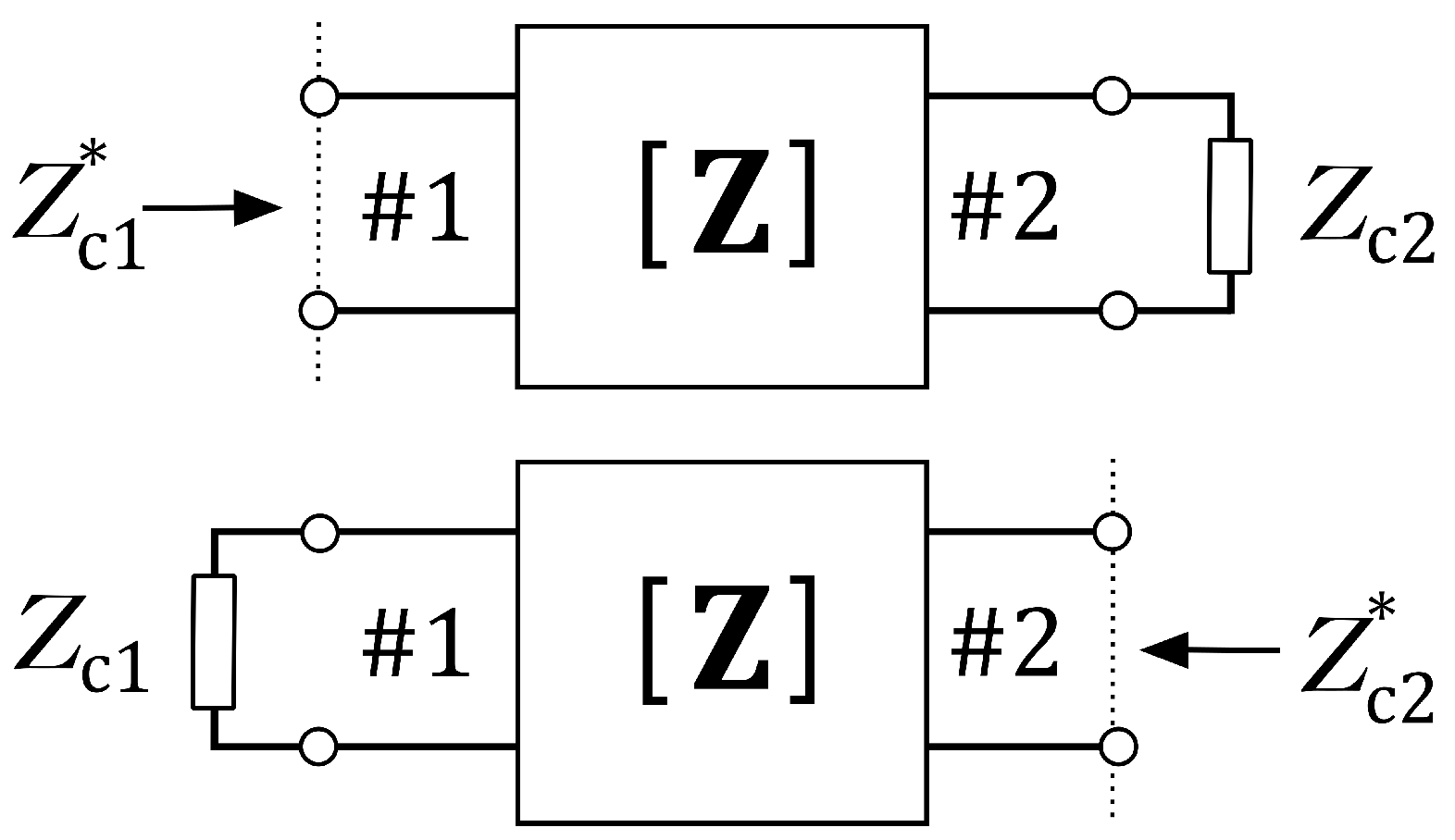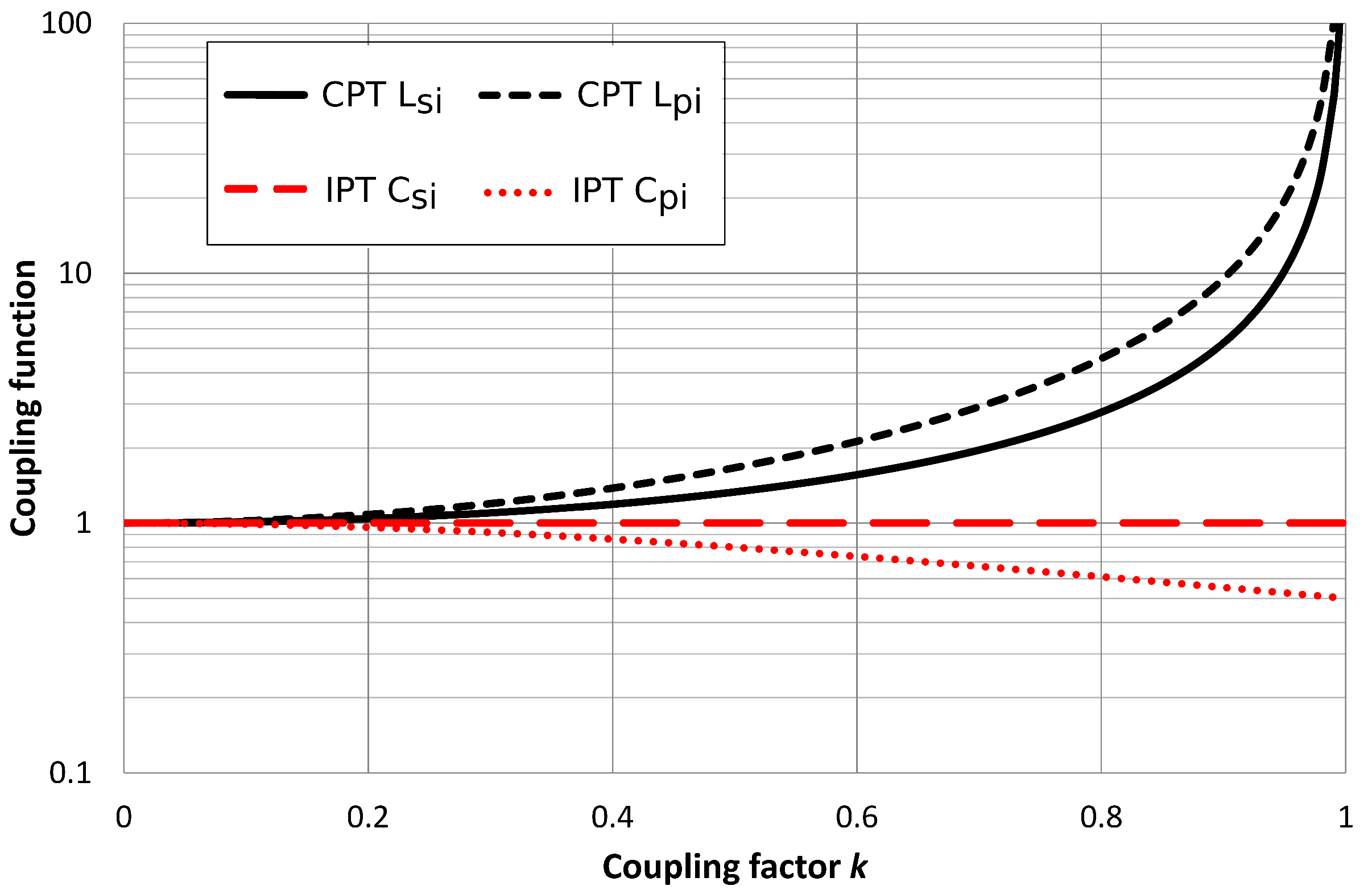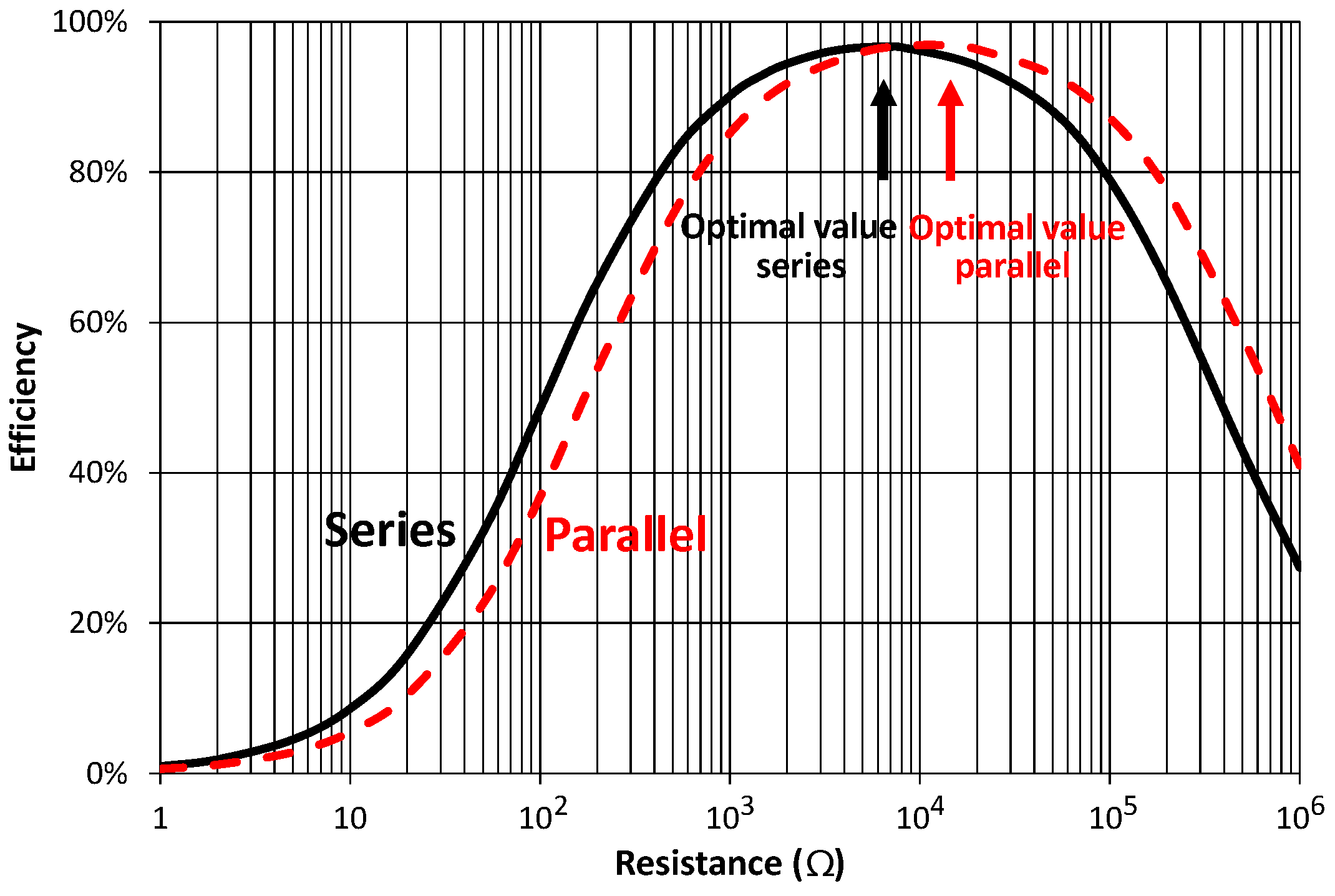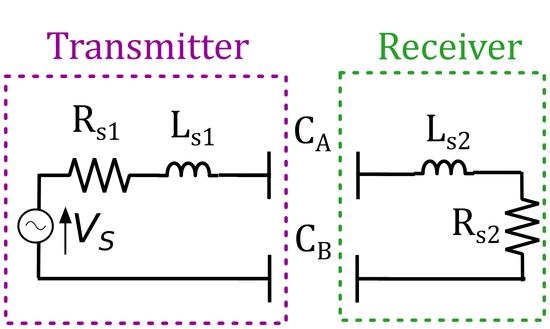2.1. A General CPT System
A general wireless power transfer link consists of a transmitter and a receiver. In a CPT system, the wireless link is realized by two conducting plates, at the transmitter and at the receiver side (
Figure 1). These plates form two non-ideal, parallel facing capacitances
and
.
In order to enhance the wireless power transfer efficiency, a compensating circuit can be connected by adding an inductance to create a resonance circuit as well at the transmitter and the receiver side. In
Figure 1, those inductances were placed in series, but also a parallel topology is possible. Thus, the transmitter of our general CPT system consists of an ideal time-harmonic voltage source at angular frequency
, a series resistance
, a series resonance inductance
and the plates of the capacitances at the transmitter side. Analogously, the receiver consists of a series resistance
, a series resonance inductance
and the plates of the capacitances at the receiver side.
Obviously,
Figure 1 is a simplification of a real CPT system, which will usually contain extra components (e.g., diode rectifier, H-bridge, power conditioner, ...). Nevertheless, we will use the simplified circuit in this study because (i) it is impossible to take into account all possible extra components that can be added, but, more importantly; (ii) it gives us the opportunity to focus on the effect of the WPT link itself, without the influences of external components. This allows a better understanding of the fundamentals of the WPT link, necessary for the design of a CPT system.
In order to correctly analyze this setup, the non-ideal capacitors have to be replaced by their equivalent circuit. A non-ideal capacitance consists of the following components (
Figure 2a) [
15,
16,
17]:
A stray series capacitance , representing the terminal capacitance.
A stray series inductance , caused by the leads and plates of the capacitor.
The series resistance caused by the plates of and connections to the capacitor.
The parallel resistance caused by the dielectric layer between the capacitor plates.
The (ideal) capacitance C itself.
In practice, the series capacitance
and inductance
are negligible compared to the ideal capacitance
C and the inductance
of the compensating WPT network. Similarly, the resistance
is large enough to justify neglecting it. This results in an equivalent circuit that is, for our application, a valid approximation for a non-ideal capacitor, consisting of the ideal capacitance
C in series with the resistance
(
Figure 2b).
Replacing the non-ideal capacitors in
Figure 1, we obtain the circuit from
Figure 3a. This circuit has the disadvantage that the transmitter and receiver are part of the same circuit. Indeed, the transmitter and receiver share both the ideal capacitances
and
. This complicates the analysis of, e.g., a CPT system with one transmitter and multiple receivers. In order to be able to evaluate each receiver separately, it is beneficial to disconnect the transmitter and receiver circuit and introduce a coupling factor. Therefore, analogous to inductive power transfer, we construct the equivalent circuit (
Figure 3b), with
and
the ideal capacitances of transmitter and receiver, respectively, and
the mutual capacitance between
and
, as defined by [
18]. The series resistances on the transmitter and receiver side, respectively, are
and
. The relationship between
,
,
and
on the one hand and
,
,
,
and
, on the other hand, can be found in [
19].
Analogous to inductive WPT, we introduce the capacitive coupling coefficient
k (also named the electric coupling coefficient), defined as [
18,
19]:
We now consider the wireless link itself as a two-port network as indicated in
Figure 3a. The wireless link is fully characterized by its impedance matrix
, with elements
(
). Since the two-port network is linear and reciprocal (
), the relationship between peak current and peak voltages (as defined in
Figure 3a) at the two ports is given by:
Taking into account the equivalent circuit of
Figure 3b, one can easily determine the coefficients of the impedance matrix
Z of the two-port network:
The impedances connected to ports #1 and #2 are
and
, respectively (as indicated in
Figure 3a).
By applying the conjugate image theory, we will determine in the next sections the optimal and to maximize the power transfer efficiency. We consider the impedance matrix and working frequency as given. In other words, given a fixed wireless link, what are the optimal impedances and to achieve maximum power transfer efficiency?
2.2. Conjugate Image Values for the Series Topology
We define the efficiency
of the capacitive link as the ratio between the active output power
delivered to a resistive load relative to the active input power
provided by the source:
It was shown by Roberts [
20] that applying the so-called conjugate-image configuration to a two-port network maximizes the power transfer efficiency from input port #1 to output port #2 and vice versa. We will apply this setup to determine the necessary network elements
and
to achieve maximum efficiency of the wireless link.
We want to stress that maximizing the efficiency of the power transfer does not correspond with maximizing the amount of transferred power to the load [
21]. It can depend on the application whether the maximum efficiency or maximum power transfer solution is preferable. For example, for the wireless charging of biomedical implants, the maximum power configuration may be preferable, whereas for the wireless charging of electric vehicles, the maximum efficiency configuration is more appropriate [
14,
22]. In the next section, we will indicate the complex conjugate with a star:
is the complex conjugate of
Z.
The conjugate image setup can be constructed by connecting specific impedances
and
to port #1 and #2, respectively [
20,
23]. It is said that the conjugate image configuration is achieved when the following conditions apply (
Figure 4):
If we terminate port #2 with a load , the impedance as seen into port #1 is .
If we terminate port #1 with an impedance , the impedance as seen into port #2 is .
For any two-port network, these conditions are fulfilled for the following values of
and
[
20,
21]:
With Equations (
4), (5) and (6), we obtain for the resistances:
and for the reactances:
These reactances match with the following inductances for the series topology of
Figure 3:
Written as a function of the coupling factor
k, we obtain the expressions in
Table 1.
In conclusion, the conjugate image theory teaches us that for maximizing the power transfer efficiency, the optimal values for the resistances and inductances in series, given a certain CPT link with impedance
Z, are given by Equations (12), (13), (
16) and (
17).
In a general CPT system, the supply will be connected to port #1 of the two-port network, whereas the load will be connected to port #2. In that case, the resistance
is redundant. It is only necessary if you want to maximize the efficiency in both directions. Indeed, the conjugate image setup not only maximizes the efficiency from port #1 (with the supply) to port #2 (with the load), but also from port #2 to port #1 if the supply and load are inverted. In other words, it allows choosing the ports at which you connect supply and load. Often, this design requirement is not imposed, and one can simply omit
, which leads to a doubling of the efficiency and corresponds to the maximum efficiency configuration of the wireless power system [
22].
2.5. Comparison between CPT and IPT
Table 3 gives an overview of the resistive and reactive components of the compensation network for achieving maximum efficiency for CPT and IPT. The table is valid for both the series and parallel topology. The expressions for IPT were derived by Inagaki [
13] and were validated for the lossless approximation. By defining the coupling function
, which is a function of the coupling factor
k, we obtain the same expressions for series and parallel topology. The coupling function
is given by the values indicated in
Table 4.
It is possible to write the values for the compensation network even more concisely than
Table 3 by expressing them with the reactance:
for the inductance and capacitance, respectively. We obtain one formula for the resistive part of the conjugate image compensation network, valid for CPT and IPT, as well for the series and parallel topology:
is the reactance of the wireless link components, i.e.,
for CPT or
for IPT. In addition, for the reactive part of the conjugate image compensation network, we obtain a single formula, valid for CPT and IPT, as well for the series as the parallel topology:
In the case of CPT,
in Equation (
29) is the reactance of the wireless link components and
is the reactance of the compensation network. For IPT,
in the above equation is the reactance of the wireless link components and
is the reactance of the compensation network.
The introduction of the coupling function
, as defined in
Table 4, allows us to write the network elements to maximize the efficiency of the wireless power transfer in two elegant Equations (
28) and (
29). We will now discuss this coupling function
for CPT and IPT, and thereby also compare the conjugate image theory between CPT and IPT. Notice that, since
, the coupling function
is only defined within this region.
Figure 6 shows the coupling function
as a function of
k for
and
for CPT and IPT. The coupling function
for the series resistance
increases monotonically for higher coupling coefficients
k. For low coupling (
), its value for CPT is practically equal to its value for IPT. For very high coupling,
rises very quickly for CPT, whereas for IPT, it converges to unity. Just as for
, the coupling function for
is also practically equal for CPT and IPT at low coupling (
). Whereas for IPT, the function decreases monotonically, it rises again, quite strongly, for CPT. Regarding the resistive part of the compensation network, we can conclude that for low coupling, the values for CPT and IPT barely differ, whereas for high coupling,
is low for IPT, but high for CPT. Notice that according to Equation (
28), this corresponds with a low
and
for IPT, and a high
and
for CPT.
Figure 7 shows the coupling function
as a function of
k for the series and parallel reactive parts of the compensation network, for CPT and IPT systems. The coupling function
for
and
increases monotonically for CPT at higher coupling coefficients
k, whereas for
, it decreases monotonically for IPT. The coupling function for
is independent of
k and remains constant at unity. For very low coupling (
), the value for
equals approximately unity in all four cases. For very high coupling,
rises very quickly for CPT. The value for the parallel topology rises a bit faster, but the difference remains small. The situation is different for IPT: for higher coupling factors,
remains at unity or goes to 0.5 for
and
, respectively. Regarding the reactive part of the compensation network, we can conclude that for low coupling, the values for CPT and IPT barely differ, whereas for high coupling,
is high for CPT and low for IPT. Notice that according to Equation (
29), this corresponds with a high inductance for CPT and a low capacitance for IPT.
According to Equations (
26), (27) and (
29),
for all
k corresponds to the natural resonance frequency of an uncoupled resonant circuit. Only the value for
(IPT) corresponds to this natural frequency. All other optimal values do not agree with this natural frequency due to the coupling between the transmitter and receiver [
24].
